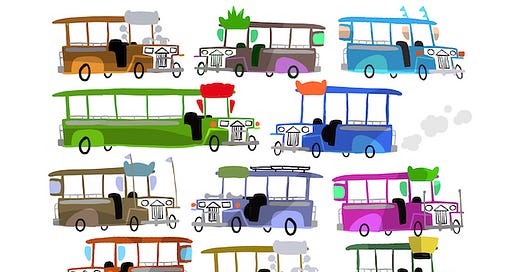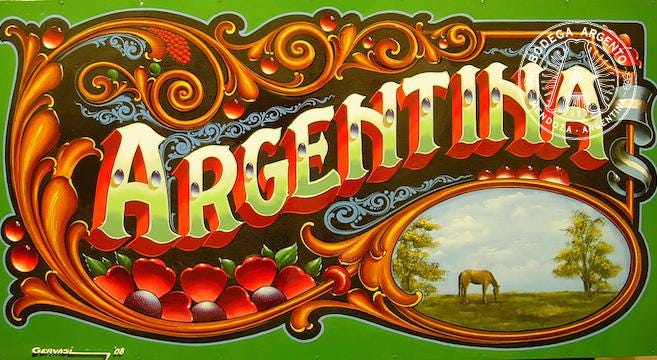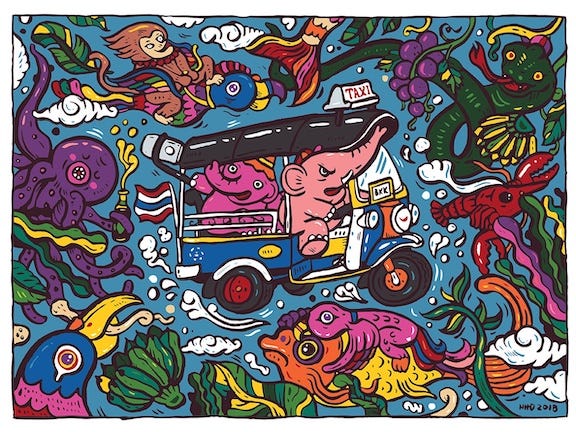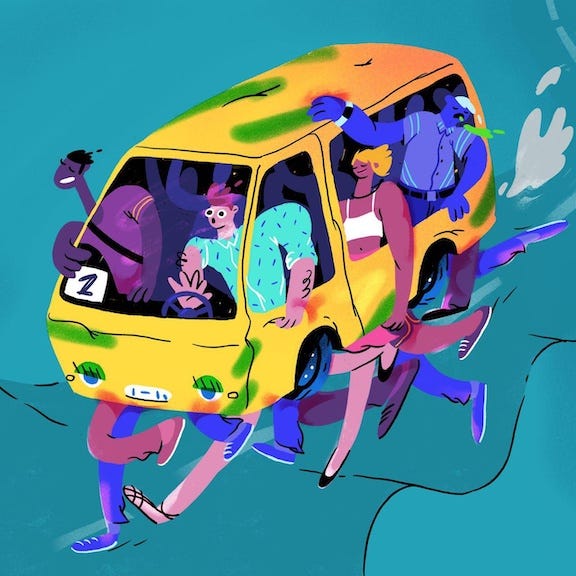Hey friend,
Hope your weekend is going well. Here’s your fortnightly serving of Makeshift Mobility, your first newsletter on innovations in informal transportation.
Your second one, of course, is Pop Transport over from my friends at the Global Partnership for Informal Transportation. They’ve got a great set of links to recent articles and research papers that would interest you.
Before we jump into this week’s issue, I have to check. Did you register for the 2021 National Shared Mobility Summit?
We kicked off our first Tuesday this past week with a great set of conversations.
We talked equity. We talked climate. We talked mobility justice. We talked NUMTOTs. And yes, informal transportation came up a couple of times. (Mostly because Mehul Malhotra brought it up. Thanks, Mehul!)
You can still catch the next three weeks at a great price. That’s three main sessions on Tuesdays and echo events on Thursdays.
There’s even a panel on Humans and Homegrown Transportation (a.k.a. informal transportation) on the 27th of this month, featuring our mutual friends Julia Nebrija, Su Sanni, and Kim Lucas.
Plus, I’m doing a meet-and-greet with Makeshift Mobility readers for the Echo Events this Thursday, July 15 at 12:30 PM to 01:00 PM US Central Time (UTC-5).
(That’s 5:30 PM GMT, a.k.a. 6:30 PM London, BST).
If that’s not enough of a come-on, I’ve also got a great deal for you.
Use this discount code and get 50% off on any ticket:
NSMS202150Go register! I’ll wait.
The decorating bug
So let’s talk fileteado. I’ve left you hanging for at least two issue now. (Three if we count the one I missed.)
What is it, you ask?
My friend, it is better seen than described. Behold:
It is as Argentine as tango. It is celebration. It is life itself!
Alright, alright. If you’re going to be academic about it, here’s a description from The Real Argentina:
Fileteado is a highly stylized art form, combining lines and decorative motifs that usually form a frame around an image or a typeface. It is instantly recognizable, and is made up of the following elements:
• Stylized lines, or “filetes”, meaning threads.
• Use of shading to create a feeling of depth within the piece.
• Rigid use of symmetry.
• The use of bold, primary colours.
• Use of Gothic or highly detailed lettering.
• Use of symbolic imagery i.e. a horse shoe to represent good luck.
• The decoration is used to frame an image or text in the center of the piece.
What does this have to do with informal transportation? Colectivos, of course!
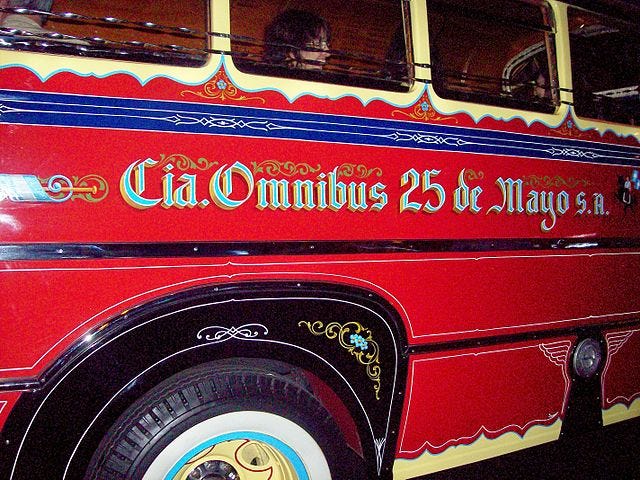
The Fileteado art form originated in Buenos Aires towards the end of the 19th century. At this time Fileteado embellished wooden carts carrying food for sale to the people. Since then it has evolved to adorn all kind of objects from signs, to taxis, old colectivos (buses), and even personal automobiles!
Fileteado started on wagons, but it flowered (sorry) on colectivos.1
As I’ve said before, there is something in makeshift mobility that is compelled to ornament, to richly decorate these vehicles that are more than utilitarian tools.
Unless forced by authorities to use specific color schemes, makeshift mobility must express itself. I think it’s part and parcel of reclaiming dignity, of establishing presence and independent identity when you are oppressed.
As David Reeve puts it (as he studied the ornamentation of angkots in Indonesia):
I came to see the popular culture expressed on the angkot and buses as showing a counter-culture, in opposition to official values.
Bryan Boyer had this stunning line in the latest issue of Urban Technology that I couldn’t help but tweet. Bryan was talking about digital technology but I think it totally applies to the ornamentation that accompanies the innovations of makeshift mobility:
“When technology makes life strange, culture—including music, dance, art, and design— provides society a way to collectively process that strangeness.”
Talking about fileteados, art, and expression gets me into a visual mood. Ok, with you if we spend the rest of this letter just looking at more makeshift mobility art?
Yes?
Yes!
Here we go.
Heho
Let’s start with this great collection of jeepney pixel art from Heho.
Fabo
Then, let me show you more jeepney art, this time from Fabo.
Fabo drew this to raise funds for fellow artist Marchushiro Nada. Please support. You can send via paypal to Marcushiro@yahoo.com.
Here are a few more of my finds from just surfing Dribble. (You may need to register to see the full sized images.)
Anukun
Here’s Elephant Riding Tuktuk by Anukun Hamala.
Oksana
Here’s Commute (The Marshrutka) by Oksana Kurmaz.
Marish
Julia
And here’s @Uber tuktuk by Julia @Artern. (I think this was part of an advertising campaign.)
Ok. That’s it for this week. I hope you enjoyed the visual stimulation.
Leave me a comment, if you please. Have a creative week!
I’m Benjie de la Peña and I’m the CEO of the Shared-Use Mobility Center. I co-founded Agile City Partners, and I am the Chair of the Global Partnership for Informal Transportation.
I’m convinced that informal transportation can be the single greatest lever to decarbonize the urban transport sector, but only if we stop ignoring it and instead learn to celebrate it.
You can read more about the history of Argentina’s colectivos here.

